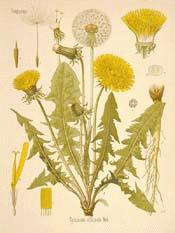Re: Flowers Around The House
Posted: Fri Mar 08, 2013 12:30 pm
I noticed yesterday that some of my crocus had pushed there way through the thatch and were blooming! 
APOD and General Astronomy Discussion Forum
https://asterisk.apod.com/
owlice wrote:Yay! for crocuses!!
I have daffodils blooming! Noticed them yesterday as I was clearing the snow (such as it was) off my car.

So, if you are lucky enough to have dandelions- don't waste 'em!Mrs M. Grieve says, in her Modern Herbal
The young leaves of the Dandelion make an agreeable and wholesome addition to spring salads and are often eaten on the Continent, especially in France. The full-grown leaves should not be taken, being too bitter, but the young leaves, especially if blanched, make an excellent salad, either alone or in combination with other plants, lettuce, shallot tops or chives.
Young Dandelion leaves make delicious sandwiches, the tender leaves being laid between slices of bread and butter and sprinkled with salt. The addition of a little lemon-juice and pepper varies the flavour. The leaves should always be torn to pieces, rather than cut, in order to keep the flavour.
John Evelyn, in his Acetana, says: 'With thie homely salley, Hecate entertained Theseus.' In Wales, they grate or chop up Dandelion roots, two years old, and mix them with the leaves in salad. The seed of a special broad-leaved variety of Dandelion is sold by seedsmen for cultivation for salad purposes. Dandelion can be blanched in the same way as endive, and is then very delicate in flavour. If covered with an ordinary flower-pot during the winter, the pot being further buried under some rough stable litter, the young leaves sprout when there is a dearth of saladings and prove a welcome change in early spring. Cultivated thus, Dandelion is only pleasantly bitter, and if eaten while the leaves are quite young, the centre rib of the leaf is not at all unpleasant to the taste. When older the rib is tough and not nice to eat. If the flower-buds of plants reserved in a corner of the garden for salad purposes are removed at once and the leaves carefully cut, the plants will last through the whole winter.
The young leaves may also be boiled as a vegetable, spinach fashion, thoroughly drained, sprinkled with pepper and salt, moistened with soup or butter and served very hot. If considered a little too bitter, use half spinach, but the Dandelion must be partly cooked first in this case, as it takes longer than spinach. As a variation, some grated nutmeg or garlic, a teaspoonful of chopped onion or grated lemon peel can be added to the greens when they are cooked. A simple vegetable soup may also be made with Dandelions.
The dried Dandelion leaves are also employed as an ingredient in many digestive or diet drinks and herb beers. Dandelion Beer is a rustic fermented drink common in many parts of the country and made also in Canada. Workmen in the furnaces and potteries of the industrial towns of the Midlands have frequent resource to many of the tonic Herb Beers, finding them cheaper and less intoxicating than ordinary beer, and Dandelion stout ranks as a favourite. An agreeable and wholesome fermented drink is made from Dandelions, Nettles and Yellow Dock.
In Berkshire and Worcestershire, the flowers are used in the preparation of a beverage known as Dandelion Wine. This is made by pouring a gallon of boiling water over a gallon of the flowers. After being well stirred, it is covered with a blanket and allowed to stand for three days, being stirred again at intervals, after which it is strained and the liquor boiled for 30 minutes, with the addition of 3 1/2 lb. of loaf sugar, a little ginger sliced, the rind of 1 orange and 1 lemon sliced. When cold, a little yeast is placed in it on a piece of toast, producing fermentation. It is then covered over and allowed to stand two days until it has ceased 'working,' when it is placed in a cask, well bunged down for two months before bottling. This wine is suggestive of sherry slightly flat, and has the deserved reputation of being an excellent tonic, extremely good for the blood.
Do you ever submit some of the more rare or unusual ones to Wikimedia Commons? I find it difficult to determined the exact species unless it's at a botanical garden with a clear label but I have taken a few photos and released them to public domain by submitting them there.Chris Peterson wrote:Finally, some wildflowers! As we took a short two mile walk around the ranch today, I came across five different types of flowers popping out of the newly moist ground. A cinquefoil variety, cactus flowers, ground hugging daisies, dandelions, and pasque flowers. Not a lot of green yet- grass and sage are just starting to poke out, currants are starting to leaf, and some small plants are showing that will likely have flowers in a few weeks- assuming everything doesn't desiccate again.
Pasque flowers are common across the entire northern hemisphere. I believe our particular variety is Pulsatilla patens. There is some variation in color, ranging from nearly white to a rich, light purple color. Some other varieties can get much darker, but we don't see those here.Ann wrote:That's a lovely pasque flower, Chris. We have something similar here, but ours is a much deeper purple color. Could your possibly be this variety?
http://www.mudbuddy.net/ wrote:
<<Join MudBuddy and his friends as they explore a world we often overlook, the ground beneath our feet! Through simple stories, humor and interaction you can help Mudbuddy and his friends learn more about the organic world around us all.>>
I have some yellow and some other colors also but aren't blooming yet!Beyond wrote:
Say, Orin, do you have any BIG Yellows??